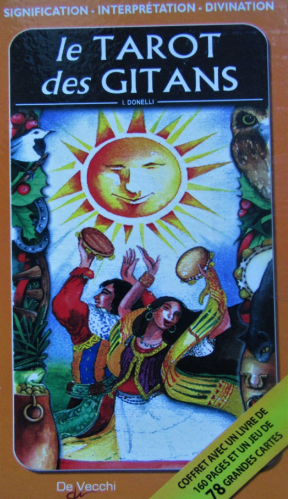The Tarot of the Gypsies: another way to understand our conditionings
- by Essence Diaries

- Nov 18, 2022
- 3 min read
I always remember the sentence of Castaneda telling us that:
“there are no ordinary moments”.
A few days ago, I went shopping to a small supermarket in Embrun. While choosing a wine, I had a look at books on sale and saw le Tarot des Gitans (the Tarot of the Gypsies). Thought it should be a good idea to open myself to something unknown. After having a look at the cards, realizing this game was subtle mingle between Christianity, Paganism and Occultism... I decided to write this article.

The mysterious origin of the Gypsies:
It has been maintained that the Gypsies were Egyptians, and even that they were the followers of Pharaoh, perhaps not yet gotten home from that Red Sea journey.
Otherwise that they are the descendants of the vagabond votaries of Isis, who were in Rome just what the Gypsies are in modern Europe. It has been argued that they were Grecian heretics; that they were persecuted Jews; that they were Tartars; that they were Moors; and that they were Hindoos....
The evidences adduced are, that the Gypsy tongue is strikingly like some Hindoo dialects and the parent Sanscrit, — that the races are similar in complexion, shape, disposition, and habits, — distinguished by the same vagrant nature, the same love of idleness, music, dancing, and thievery. In this course of argument, that founded upon the language is of course the really strong one. Early European references describe wandering, nomadic communities who were known for their music and skill with horses.
They arrived in Spain in the 15th century or earlier – with records of groups of up to a hundred Gypsies travelling together, often led by someone who termed himself a "count" or "duke" – and held on despite attempts to expel them or imprison those who refused to give up their language and culture.
They were accompanied by a legend that they had been expelled from Egypt for trying to hide Jesus.
The new study now sets their arrival in Europe in the sixth century – a time when Britain was still in its early post-Roman era. Gypsies, often referred to as Roma, are found across all of Europe and make up the continent's largest ethnic minority.
Seeing a high form of magic in their Tarot!
The biggest contribution of the gypsy is said to be in occultism. Fortune telling, tarot card, shamanism, spells, talismans are attributed to the gypsies. But the symbolism throughout the cards has made me aware of how we were conditioned by the religious system or the empire state building, even within Marseilles Tarot.

What attracted me while looking at the arcana is the magic they’ve put on their drawings. It is also very important to see how the names of the Marseilles tarot characters compared to the Gypsies ones show the impact of authority and obedience.
Here are a few examples:
The Emperor (Marseilles tarot) is the Smith (Gypsies tarot).
The Impress (Marseilles tarot) is Ana (Gypsies tarot) a fairy.
The Pope (Marseilles tarot) is the great Blacksmith (Gypsies tarot).
The Popess (Marseilles tarot) is Sarah (Gypsies tarot).
Ouroboros or wheel of fortune?

The Ouroboros is an ancient symbol depicting a serpent or dragon eating its own tail. The name originates from within Greek language; (oura) meaning "tail" and (boros) meaning "eating", thus "He who eats the tail".
The Ouroboros represents the perpetual cyclic renewal of life and infinity, the concept of eternity and the eternal return, and represents the cycle of life, death and rebirth, leading to immortality, as in the Phoenix. I wanted to finish this text with a wink to don Juan teachings, arguing that
“words are power”.
It is obvious that “wheel” or “fortune” resonates stronger in our unconscious than “Ouroboros” (snake) or “owl”. Maybe a key to access the Silent knowledge.




Comments